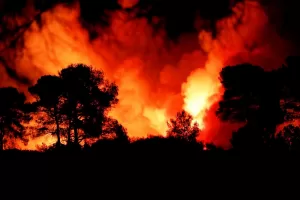Once again the Midi is burning. The Prefecture of the Aude announced yesterday that we have had 288 fires in the Department since June. In the Var, In the Var, just along the coast 8,000 hectares of forest and garrigue burnt down. Every day we see post on Facebook about new outbreaks of wild fire. A glance at the news shows major fires all around the Mediterranean basin, in the US and Australia. It is not just the Midi burning every Summer it feels like the world is alight.
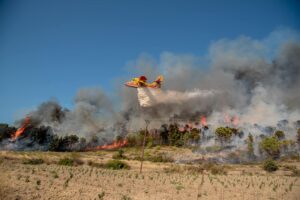 More immediately we hear the Dash and Canadair fire fighting planes in the air. Living on a mountain surrounded by forest in the middle of a drought has it’s occasional downsides. Not many but the idea that we could be burnt out is definitely one of them. Last week our valley filled with smoke, the vanilla smell of burning pine and the harsh acidity of burning oak. A sea wind was bolwing it in from a fire between Salse near the coast and Opouls, over 40 kilometres away?
More immediately we hear the Dash and Canadair fire fighting planes in the air. Living on a mountain surrounded by forest in the middle of a drought has it’s occasional downsides. Not many but the idea that we could be burnt out is definitely one of them. Last week our valley filled with smoke, the vanilla smell of burning pine and the harsh acidity of burning oak. A sea wind was bolwing it in from a fire between Salse near the coast and Opouls, over 40 kilometres away?
 Our side of Mont Tauch, the mountain of the Yew in Occitan, was denuded of trees in the mid 18th to 19the century to feed the forges of Padern and Montgaillard. A yew tree has not grown on Mont Tauch for 100 years. It is now covered by young green and white oak, and scrub garrigue type land where the vines use to be. Where the ONF, the French version of the Forestry Commission which manages the publicly owned land, has intervened it is mainly to plant quick growing evergreens, these are now being harvested by private contractors and the land left vacant. Villages who own forest annually parcel out small plots for residents to cut firewood. The cleared land is left to naturally regrow. As for privately owned forest some is harvested for wood, both by the owners and professional wood cutters, again after been cleared it is usually left to regrow by itself, but most is relatively inaccessible and has been left unmanaged.
Our side of Mont Tauch, the mountain of the Yew in Occitan, was denuded of trees in the mid 18th to 19the century to feed the forges of Padern and Montgaillard. A yew tree has not grown on Mont Tauch for 100 years. It is now covered by young green and white oak, and scrub garrigue type land where the vines use to be. Where the ONF, the French version of the Forestry Commission which manages the publicly owned land, has intervened it is mainly to plant quick growing evergreens, these are now being harvested by private contractors and the land left vacant. Villages who own forest annually parcel out small plots for residents to cut firewood. The cleared land is left to naturally regrow. As for privately owned forest some is harvested for wood, both by the owners and professional wood cutters, again after been cleared it is usually left to regrow by itself, but most is relatively inaccessible and has been left unmanaged.
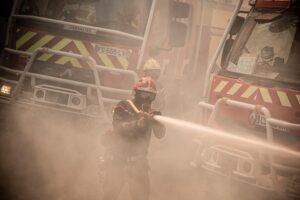 The other side of Tauch, above Tuchan is virtually totally denuded, a forest fire a couple of years back between Paziols and Padern brunt down 1;200 hectares of land in day. Most of the land that burnt was abandoned agricultural land, garrigue and the remains of cleared evergreen plantations. Some vines were touched, more the organic vines that plant green fertiliser, and plants that fix minerals and support soil formation at the feet of the vines less the industrially worked vines that plough between then rows of vines. . Only one habitation was hot by the fire, and that was terrifying, the fire swept round the trees that surrounded there house, melting the polytunnel where they grow vegetables, the car parked 5 metres from the house burnt but amazingly the house itself was untouched. It is a stone built old bergerie, shepherds dwelling.
The other side of Tauch, above Tuchan is virtually totally denuded, a forest fire a couple of years back between Paziols and Padern brunt down 1;200 hectares of land in day. Most of the land that burnt was abandoned agricultural land, garrigue and the remains of cleared evergreen plantations. Some vines were touched, more the organic vines that plant green fertiliser, and plants that fix minerals and support soil formation at the feet of the vines less the industrially worked vines that plough between then rows of vines. . Only one habitation was hot by the fire, and that was terrifying, the fire swept round the trees that surrounded there house, melting the polytunnel where they grow vegetables, the car parked 5 metres from the house burnt but amazingly the house itself was untouched. It is a stone built old bergerie, shepherds dwelling.
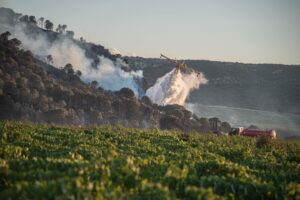 The fire in the Var however was much larger and destructive. A dangerous combination of drought and high winds meant that the fire swept through the forest and garrigue at incredible speed, cutting off home owners and fire fighters alike, the police and ambulance had to evacuate thousands of residents and tourists as the fire spread from 4.000 hectares to 8;000 in less than 24 hours. So intense was the heat that there was a real fear that burning embers would be blown from the mainland to Corsica.
The fire in the Var however was much larger and destructive. A dangerous combination of drought and high winds meant that the fire swept through the forest and garrigue at incredible speed, cutting off home owners and fire fighters alike, the police and ambulance had to evacuate thousands of residents and tourists as the fire spread from 4.000 hectares to 8;000 in less than 24 hours. So intense was the heat that there was a real fear that burning embers would be blown from the mainland to Corsica.
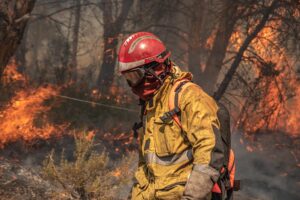 Now the Var is not the Corbieres, and certainly not the Hautes Corbieres. Before embarking on our aromatic and medicinal plant growing experiment Caroline and I went on a little adventure to visit Grasse, the traditional heart of the French perfume industry. The idea was to learn a little more about how plants were used to make perfume and have a little holiday as well. Where better than Provence, with it’s lavender and lavandin field?
Now the Var is not the Corbieres, and certainly not the Hautes Corbieres. Before embarking on our aromatic and medicinal plant growing experiment Caroline and I went on a little adventure to visit Grasse, the traditional heart of the French perfume industry. The idea was to learn a little more about how plants were used to make perfume and have a little holiday as well. Where better than Provence, with it’s lavender and lavandin field?
Grasse lies in the hills behind Cannes and St Tropez. It is a staggering beautiful part of France. Deep gorges carry the water from the alps down to the coastal plains, there are even some lavender fields left, although as one of our guides explained most of the essential oils used in modern perfume production in France are now imported as they are cheaper than locally produced one.
As I say the back country is breath taking, the coast not so much. My old job use to take me to Cannes for film, music and media festivals and I have vowed never to go back again to the concrete monstrosity that is the Palais des Festivals. As for St Tropez it is now far from the sleepy fishing village discovered by Brigette Bardot, it is now a monument to excessive wealth, conspicuous consumption and crass overindulgence. But what staggered me the most looking down from Grasse was the omnipresence of white villas. The lottissements of box like new builds that have spread out from most twins and villages in the Midi has now covered every inch of land between Grasse and Cannes. Shaded by the Cypresses and Aleppo pines these villas, each ith their own pools and imported old olive trees have now all joined up to provide a carpet of urbanisation that stretches as far as the eye can see. Coastal Provence needs a new sigh on its frontiers, Complete, Full.
No wonder then that the fire lead to thousands of people being evacuated.
By chance we had lunch in Grasse that day. we got to the restaurant early so they gave us a table on the terrace, a table four for for the two of us. To cut a long story short they asked us if we would mind sharing as they were full; A local couple joined us and we got chatting about our part of France and comparing it to the area around Grasse. Caroline commented on the urban spread, “It’s a nightmare an absolutely nightmare” the man responded. Turns out he was a full time fireman working at the local caserne, fire station. The fire service is contacted every time a new planning application is submitted, and they systematically oppose every new development in the forest, and are equally systematically ignored. His partner worked in a local Mayor’s office, she told us that her Mayor knew the dangers the new build represented but the pressure on them to protect their budget in the face of annual cuts meant that they tended to approve most new build plans. It is not simply a question of budget, in France more and more local decisions rea made not at a Commune level, that is the village or town Mayor, but at a Canton and Inter communal level. hat this means is that small villages tend to be steam rolled by their larger neighbours. The bigger a commune’s population the more weight the Mayor’s wishes have on what is decided.
This reflects a more national trend. France is simply getting older. Like most developed European countries. Upon retirement a portion of the population opt to move South. Why not? You can sell the family apartment or house, buy a brand new purpose build single story villa with a garden that will last you for the rest of your life, who apart from second homers wants the hassle of doing up an old village house, buy a new car and still have change to install a swimming pool. the Ile de France is slowly emptying and the South of France rapidly filling up.
This demographic shift has a number of knock on effects, on the provision of medical services, on water supply, on voting habits, the Midi Rouge is slowly turning blue, and sadly deep blue, from the coast inwards. And on fires. “These city people don’t know how to live in the countryside” our friendly fireman told us before regaling us with stories about barbeques setting fire to trees and garden fires burning don the house . His husband agreed, telling us of complaints the Mayor receives about tractors driving by at 5am in the morning, about farmers crop spraying.
The other effect is on the price of land. Even around here in the lower Corbieres a building lot starts at 50,000 euro. I would no like to hazard a guess on what building lots in Provence costs. Land on the edge of villages is at an all time premium. Some good agricultural land is being eaten up by urban spread but also villages are extending into the surrounding forest and garrigue. Both increasing the risk of fires and the impact of fire on human habitation.
However it is one thing to lament the slow invasion of the Midi by the North, and EU migrants like ourselves but it is another to blame them, and us, for the Midi burning, the increase in both the number of forest fires and their destructiveness has it’s causes else where. .
Two factors are at the root of problem, climate change and the retreat of farming from marginal land. Climate change has lead to longer, hotter and dryer Springs and Summers all around the Mediterranean basin. The abandonment of marginal land has extended the young forest and garrigue scrub land. Sheep and goats no longer clear the ground cover in the forest and old vines. The combination of the to have created a tinderbox that is just awaiting a careless cigarette butt thrown out of a car window or a broken beer bottle left by a walker.


